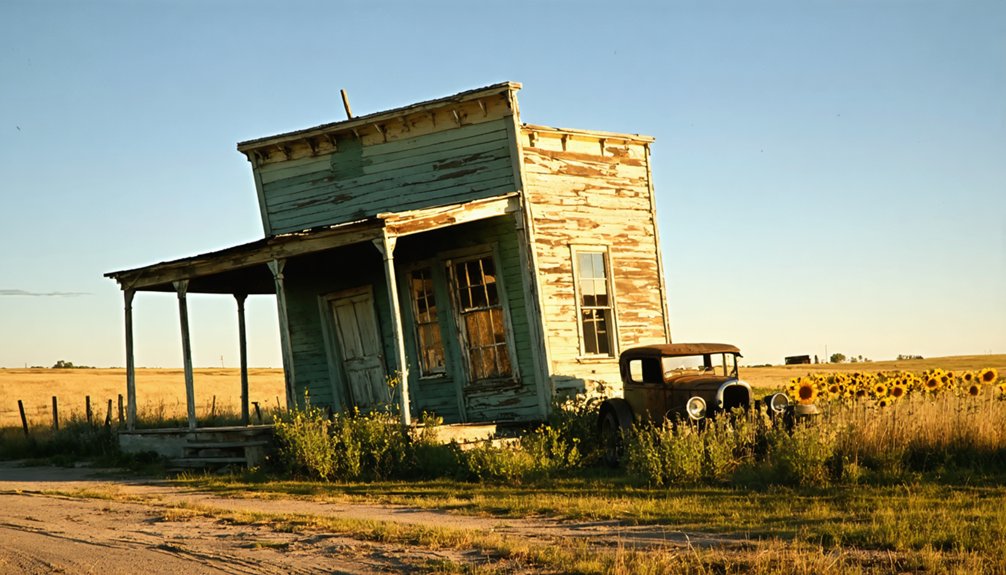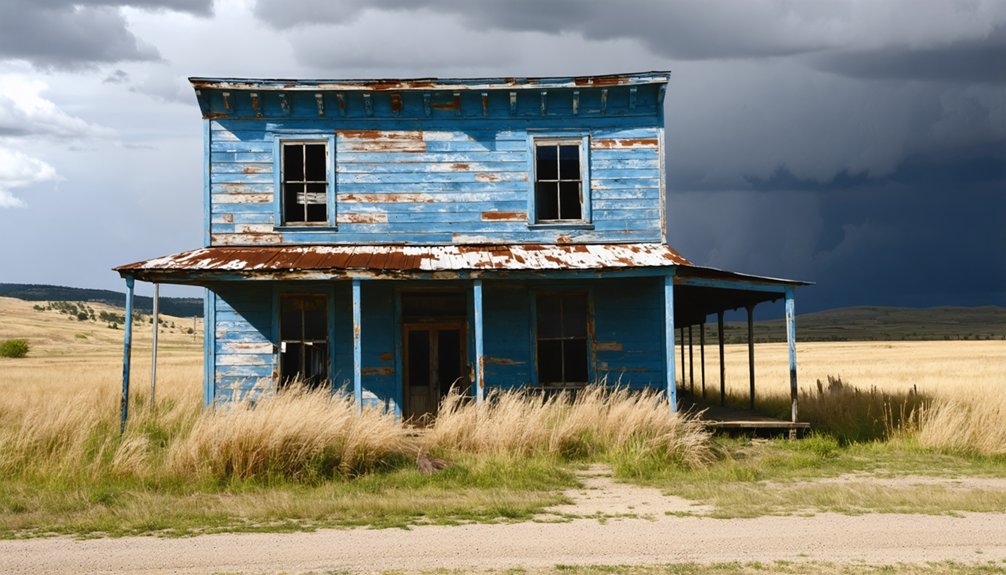You’ll find Oak Flat nestled in South Dakota’s Black Hills, just 2.5 miles east of Deadwood. Once a bustling lumber town centered around the E. Bowen Lumber Mill, this settlement thrived in the late 1800s thanks to the railroad connection and timber trade. The historic Megary Hotel served as the heart of the community, hosting celebrations and weary travelers. Today, Oak Flat’s ghostly foundations whisper stories of its lumber camp heritage and railroad glory days.
Key Takeaways
- Oak Flat is a ghost town located 2.5 miles east of Deadwood, South Dakota, known for its historic lumber industry.
- The town flourished around the E. Bowen Lumber Mill and was connected to Dumont via the Hanna railroad spur line.
- The Megary Hotel served as a community hub for travelers and loggers before the town’s eventual abandonment.
- Oak Flat’s decline paralleled other railroad-dependent towns as improved roads allowed residents access to larger cities.
- No verifiable structures remain today, with modern surveys designating the location as “barren” with only scattered foundations visible.
Location and Settlement Origins
Nestled in the scenic Black Hills of South Dakota, Oak Flat sits just 2.5 miles east of historic Deadwood along the winding Centennial Road to Crook.
Hidden in the majestic Black Hills, Oak Flat awaits discovery near Deadwood, a testament to South Dakota’s untamed beauty.
Like many towns that depended on the railroads, Oak Flat’s eventual decline mirrored settlements such as Okaton which saw its community dwindle after the tracks became disused.
You’ll find this ghost town’s settlement history deeply rooted in the region’s bustling lumber trade, where the E. Bowen Lumber Mill once stood as a reflection of the area’s economic development.
Much like the current black and white photographs captured by Keith Dotson, the weathered remains tell stories of the town’s bygone era.
In its heyday, Oak Flat served as both a thriving lumber camp and essential shipping point for cattle operations.
The railroad played a key role in the town’s growth, maintaining a section house and connecting to nearby Dumont via the Hanna spur line.
Though you’ll find few traces of the original structures today, this once-busy settlement embodied the pioneering spirit of South Dakota’s early industrial expansion in the Black Hills region.
The Lumber Industry’s Legacy
You’ll find that Oak Flat’s lumber operations mirrored the broader Black Hills industry, where dozens of sawmills transformed the landscape by 1900.
Local timber fed the region’s insatiable appetite for construction materials, with sawmills processing lumber for everything from mine supports to homestead cabins. The industry truly took off when John Frances Murphy established the area’s first sawmill in 1876. The rise of timber policies began with Forest Reserve land in 1897, bringing new oversight to logging operations.
The steady hum of mill saws echoed through these hills until the early 1900s, when stricter forest management practices began to reshape how timber was harvested.
Mill Operations Details
When the Black Hills gold rush sparked an unprecedented demand for lumber in 1876, John Frances Murphy’s pioneering sawmill in Custer marked the beginning of a transformative era in the region’s lumber industry.
You’d soon find sawmills popping up across Rockerville, Rapid City, and Deadwood as lumber demand skyrocketed, particularly from mining operations like the mighty Homestake Mining Company.
The industry’s evolution brought remarkable sawmill innovations, transforming from simple manual operations to sophisticated facilities.
By 1940, you would’ve witnessed Homestake’s state-of-the-art mill in Spearfish, a demonstration of technological progress.
While these advancements improved efficiency, they also meant higher operational costs for local loggers who’d to invest in modern equipment to stay competitive in this rugged frontier industry.
Timber Trade Impact
The sprawling timber trade left an indelible mark on Oak Flat and the surrounding Black Hills region, transforming dense old-growth forests into bustling centers of commerce by the late 1800s.
You’d have seen massive logging operations clear up to 75% of standing trees, driven by the voracious appetite of mining companies like Homestake that needed lumber for underground supports. Modern harvesting practices now target trees with 9 inches in diameter or larger for commercial value.
While logging regulations emerged in 1905 under the Forest Service’s watch, and timber sustainability practices slowly took root, the damage was already done. Like the Apache Leap deaths in Arizona’s Oak Flat, where 75 warriors perished, the decimation of these forests marked another tragic loss of indigenous heritage.
The landscape you see today bears little resemblance to those majestic old-growth forests. Yet this transformation built the region’s economy, with sawmills dotting the Black Hills and towns like Custer thriving on lumber production until recent decades, when operations like Neiman Enterprises finally closed their doors.
Life at the Megary Hotel
Life at the Megary Hotel centered around its role as an essential community hub in Oak Flat, where travelers, loggers, and locals gathered to share news and find respite.
Similar to the historic Tudor Revival style hotels of the era, the Megary Hotel exemplified architectural grandeur in early South Dakota.
You’d find the hotel buzzing with community gatherings, where local stories were shared and relationships forged amid the backdrop of South Dakota’s rugged frontier spirit. The hotel, like the historic Corn Palace, became known for hosting annual community celebrations that drew visitors from across the region.
The Megary Hotel wasn’t just a place to rest – it was the heart of Oak Flat’s social scene:
More than lodging, the Megary Hotel pulsed as Oak Flat’s vibrant social core, where community bonds flourished and stories intertwined.
- Served as the town’s primary meeting spot for trading news and information
- Hosted social events and celebrations for the tight-knit community
- Provided a warm welcome to weary travelers and lumber mill workers
- Created lasting memories as the center of local commerce and entertainment
The hotel’s presence offered freedom from isolation in this remote outpost, where the spirit of the American West lived on through every guest’s story.
Transportation and Accessibility
You’ll find Oak Flat ghost town about 2.5 miles east of Deadwood along Centennial Road, though today’s gravel paths offer a much humbler approach than the bustling railroad connection points of the early 1900s.
When the trains still ran through here, Oak Flat served as a crucial transportation hub for both agricultural shipments and travelers making their way across the region’s expanding frontier. Like many frontier towns, Oak Flat’s development was driven by the Chicago Northwestern Railway in 1906. Many ghost towns like Oak Flat saw their demise when better roads allowed residents greater mobility to larger cities.
The railroad’s eventual departure in the 1980s left the town dependent on rural road networks, transforming what was once a well-connected community into a remote destination accessible mainly by private vehicle over unpaved country roads.
Historical Travel Routes
Throughout South Dakota’s rich history, travelers navigated a complex network of routes that shaped the region’s development. From early exploration by Lewis and Clark along the Missouri River to the establishment of essential freight routes, these pathways became lifelines for settlers and traders alike.
- You’ll find traces of the historic bull trains that once lumbered between Fort Pierre and Deadwood, with oxen hauling precious cargo across the untamed landscape.
- You can retrace the paths of mule trains that offered speedier transport despite their higher maintenance costs.
- The Medora-Deadwood stage line opened up the territory to adventurous passengers from 1884 to 1886.
- You’re following in the footsteps of countless pioneers who blazed these trails, creating the foundation for today’s modern transportation network.
Road Access Today
While reaching Oak Flat requires careful planning today, modern travelers face a unique set of challenges distinct from their historical counterparts.
You’ll need a reliable vehicle, as the area’s remote location means limited public transportation options. Road conditions can vary dramatically with the seasons, and you’ll want to check weather forecasts before heading out.
For the best travel tips, connect with local information centers and community members who know the terrain. You’ll need to pack emergency supplies and guarantee your vehicle’s equipped for rural driving.
Don’t count on consistent cell service, and keep detailed maps or GPS devices handy. During winter months, some access routes might close entirely, so it’s worth investigating alternative paths to reach this historic site.
Railroad Connection Points
Many critical railroad connections once linked Oak Flat to South Dakota’s broader transportation network during the Great Dakota Boom of 1878-1887.
The town’s railroad history reflects the era’s pattern of town relocation, with settlements either thriving or diminishing based on their proximity to the rails.
- You’ll find remnants of the Dakota Southern Railway’s influence, which operated an essential 189.7-mile stretch between Kadoka and Mitchell.
- The area’s grain elevators and warehouses stood alongside rail sidings, marking bustling transport hubs.
- Mail service and passenger transport flowed through local depots, which served as community gathering points.
- You can still trace where the rail lines connected Oak Flat to the region’s agricultural and mining operations, though many tracks have since been railbanked.
Decline and Abandonment
As the economic landscape of the Black Hills shifted in the early 20th century, Oak Flat’s destiny followed a path all too familiar to small, industry-dependent towns of the region.
Economic downturns hit the community hard as the lumber industry waned and railroad traffic diminished, triggering a steady population migration toward larger settlements like Deadwood.
You’ll find no traces today of the once-bustling E. Bowen Lumber Mill or the welcoming Megary Hotel.
The town’s decline was quiet but absolute – families packed up, schools closed, and services vanished one by one.
Unlike some Black Hills ghost towns that preserve their historic structures, Oak Flat has returned to nature.
Only scattered foundations remain beneath the grass, silent witnesses to a community that once called this place home.
Present-Day Ghost Town Status

Research into Oak Flat‘s present-day status reveals a problematic lack of reliable historical documentation.
While ghost town myths often capture the imagination, historical accuracy demands acknowledging when claims can’t be verified. You’ll find Oak Flat briefly mentioned in some South Dakota ghost town lists, but with no substantial evidence of its existence or remains.
- No verifiable structures, foundations, or artifacts mark any location called Oak Flat.
- Modern surveys and historical records fail to pinpoint a specific geographical site.
- The designation “barren site” suggests complete absence of visible remnants.
- Historical records provide insufficient details to confirm Oak Flat’s past status as a settlement.
If you’re exploring South Dakota’s authentic ghost towns, you’ll need to focus on documented locations with verified histories, as Oak Flat’s existence remains unsubstantiated by credible sources.
Frequently Asked Questions
Were Any Notable Crimes or Lawless Incidents Recorded in Oak Flat?
You won’t find any documented crimes or unsolved mysteries here – despite local legends that might suggest otherwise, this quiet lumber mill town never experienced the lawlessness common to other frontier settlements.
What Native American Tribes Originally Inhabited the Oak Flat Area?
Hold your horses – you’ll find the Lakota people were the primary inhabitants of this area, with their tribal influence running deep through the land’s spiritual and cultural roots.
Did Oak Flat Have Its Own School System or Church?
You won’t find records of dedicated schools or churches in this area. The town’s school history and church significance likely centered around nearby communities or informal gatherings in homes and shared spaces.
What Was the Peak Population of Oak Flat During Its Heyday?
You’d find around 50-75 people called Oak Flat home during its heyday, typical of small ghost town history before population decline hit these isolated mining and lumber communities of the Black Hills.
Were There Any Significant Natural Disasters That Affected Oak Flat?
While time’s wheels have turned endlessly, you won’t find any documented major natural disasters that struck Oak Flat. Historical impacts on this town were likely more economic than Mother Nature’s doing.
References
- https://icatchshadows.com/okaton-and-cottonwood-a-photographic-visit-to-two-south-dakota-ghost-towns/
- https://www.youtube.com/watch?v=c8u4x31tzlo
- https://www.sdpb.org/rural-life-and-history/2023-08-21/some-black-hills-ghost-towns-and-their-origins
- https://www.sdhspress.com/journal/south-dakota-history-2-2/some-black-hills-ghost-towns-and-their-origins/vol-02-no-2-some-black-hills-ghost-towns-and-their-origins.pdf
- https://www.youtube.com/watch?v=_0WNYsFLSLA
- https://www.treasurenet.com/threads/lost-ghost-town-is-it-real.68311/
- https://en.wikipedia.org/wiki/List_of_ghost_towns_in_South_Dakota
- https://www.onlyinyourstate.com/experiences/south-dakota/capa-ghost-town-sd
- https://supernatural.fandom.com/wiki/Cold_Oak
- https://photobyjohnbo.com/2021/01/26/okaton-south-dakota/



